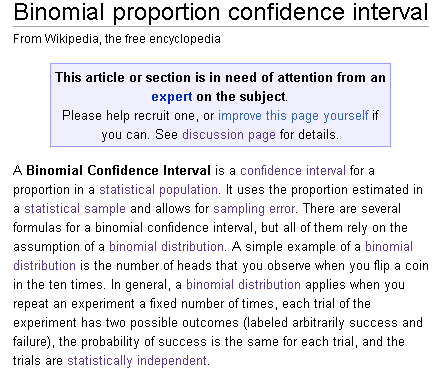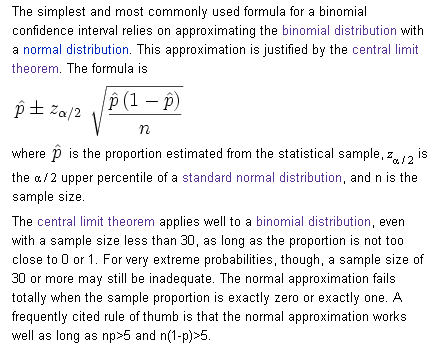Here’s my first attempt to improve the Wikipedia entry on the binomial confidence interval. I start by simplifying and improving the introduction
A ‘‘‘Binomial Confidence Interval’’’ is a [confidence interval] for a proportion in a [statistical population]. It uses the proportion estimated in a [statistical sample] and allows for [sampling error]. There are several formulas for a binomial confidence interval, but all of them rely on the assumption of a [binomial distribution]. A simple example of a [binomial distribution] is the number of heads that you observe when you flip a coin in the ten times. In general, a [binomial distribution] applies when you repeat an experiment a fixed number of times, each trial of the experiment has two possible outcomes (labeled arbitrarily success and failure), the probability of success is the same for each trial, and the trials are [statistically independent].
and including the classical formula that relies on a normal approximation.
The simplest and most commonly used formula for a binomial confidence interval relies on approximating the [binomial distribution] with a [normal distribution]. This approximation is justified by the [central limit theorem]. The formula is
where is the proportion estimated from the statistical sample, is the upper percentile of a [standard normal distribution], and n is the sample size.
The [central limit theorem] applies well to a [binomial distribution], even with a sample size less than 30, as long as the proportion is not too close to 0 or 1. For very extreme probabilities, though, a sample size of 30 or more may still be inadequate. The normal approximation fails totally when the sample proportion is exactly zero or exactly one. A frequently cited rule of thumb is that the normal approximation works well as long as np>5 and n(1-p)>5.
Here’s a screen shot of my changes

and

I also experimented with some messier formulas. Here is the TeX code
and here is what the equations look like


There is no entry for standard normal distribution, and the entry on statistical sample
is flagged by Wikpedia as a stub (an entry that is short and provides insufficient information). So it looks like there would be plenty of work for me if I wanted to do more with Wikipedia.
You can find an earlier version of this page on my old website.